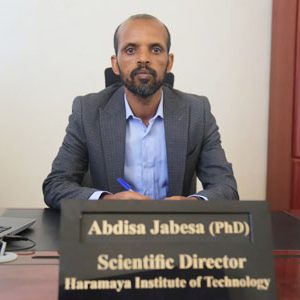Scientific Director

Dr. Abdisa Jabesa
Contact Details
- Mobile Number: +251 912 327 387
- Office Number: +251 255 530 359
- Email Address:
abdijabu@gmail.com /
abdisa.j@haramaya.edu.et
Message from the Scientific Director
Dear Students, Colleagues, Partners, and Visitors,
It is a privilege to serve as Scientific Director of HiT, a vital arm of Haramaya University driving engineering and technological innovation. Since joining the university in 2010, I’ve witnessed HiT’s growing role in supporting agriculture and health our institutional centers of excellence through practical solutions, skilled graduates, and research tailored to regional and national development. As Ethiopia embraces educational reform and Haramaya University moves toward autonomy, HiT is re-aligning its priorities to become one of the country’s top three Institutes of Technology with global recognition by 2030. Five undergraduate programs Civil, Chemical, Electrical & Computer, Mechanical, and Water Resources & Irrigation Engineering are undergoing national accreditation, with steps toward international recognition. Additional programs are queued for future accreditation, and new BSc offerings in Architecture, Automotive, and Biomedical Engineering are being introduced. Our postgraduate portfolio now includes 15 MSc and 4 PhD programs, with a new PhD in Food Science & Nutrition underway.To our students, I recognize the challenges posed by national exit exams. These reforms aim to uphold academic quality, and HiT is committed to preparing you not just for exams, but for leadership in innovation and societal transformation. Strategic actions have been launched to strengthen our institutional direction: a Grant Hunting Team to boost research funding, enhanced lab-to-industry linkages, improved planning, and academic dialogue platforms. We’re also establishing a peer-reviewed journal in engineering and technology, advancing innovation incubation, and deepening alumni engagement for mentorship and visibility. HiT’s future depends on our collective effort. With experienced staff, emerging academics, and driven students, we aim to foster professionalism, collaboration, and continuous improvement. I invite all members of our community to join us in building a platform where engineering serves society and innovation drives national progress.
Thank you for your trust and partnership.
Duties and Responsibilities
The Scientific Director of the Institute holds a pivotal leadership role, serving as a member of the Executive Management Committee of the University and overseeing the administration of the Institute to fulfil its mission. This includes ensuring compliance with relevant proclamations, directives, and laws, while fostering an environment conducive to learning, teaching, research, technology transfer, and business incubation. The Director is responsible for proposing the internal organizational structure of academic units, recommending candidates for key leadership positions such as the Managing Director and Deputy Scientific Director, and appointing directors for undergraduate, postgraduate, research, and external relations programs.
The director establishes and lead reform teams, appoint academic unit heads, and ensure their effective performance in alignment with university legislation. Strategic planning, research policy development, and the creation of guidelines for business incubation are also under the Director’s purview. The Director ensures the Institute maintains strong connections with academic institutions, agencies, industries, and associations locally and internationally. The director determines governance structures for academic units, design nomination and appointment systems, and develop governance guidelines for academic staff. Employment and office assignments are conducted competitively, with removals based on performance, discipline, or tenure completion. The Director prepares the academic calendar, manages budgets and financial records, and ensures transparency and accessibility of institutional data. The director oversees revenue generation and utilization, report regularly to the Supervisory Board and other authorities, and maintain safety and security systems. Representing the Institute in external dealings, the Director may enter into contracts with presidential consent and authorize procurements. Additionally, the Scientific Director chairs Academic and Management Council meetings, ensures decisions align with institutional and governmental interests, appoints committee chairpersons, and acts decisively in emergencies or unforeseen situations. At the start of each academic year, the director convenes General Assemblies to present performance reports, future plans, and address
stakeholder concerns.

